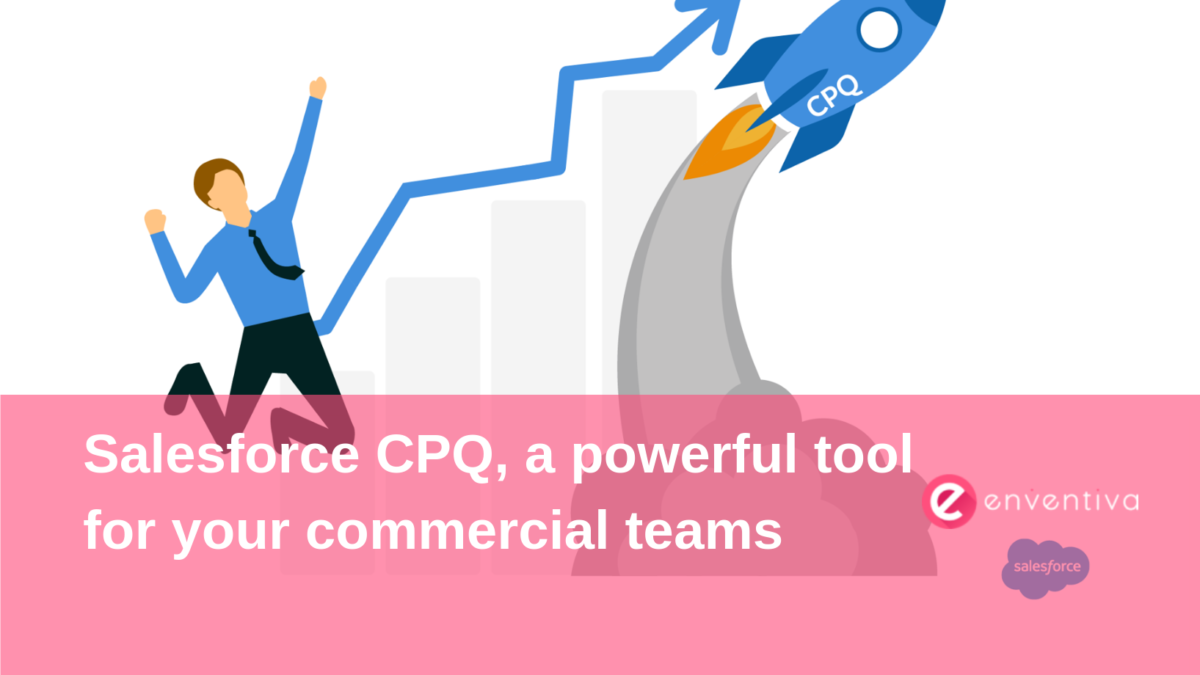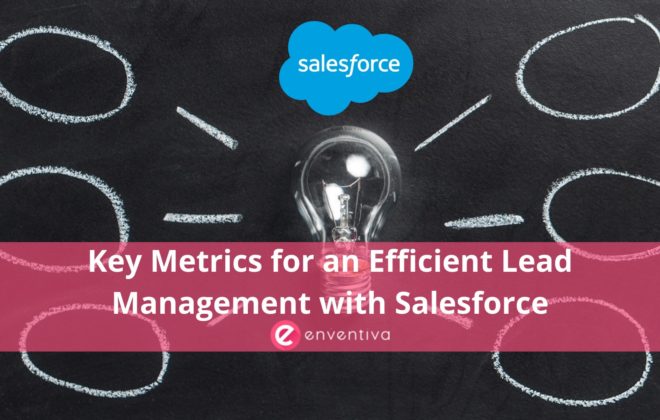Building a seamless and efficient lead-to-cash process with Salesforce CPQ
Why should you manage your quote-to-cash process in the Salesforce platform? In this expert opinion, Enventiva, partner of the leading CRM software vendor, highlights the benefits of Salesforce CPQ for a sales pipeline more efficient than ever.
What is Salesforce CPQ ?
Salesforce CPQ (Configure, Price, Quote) is a powerful tool that covers the whole quote-to-cash process. The solution is the fruit of the acquisition of SteelBrick by Salesforce in 2016. It is designed to meet the specific needs of business to business (B2B) selling.
Which advantages do Salesforce CPQ provide?
Compared to spreadsheets and other standalone solutions, often used for pricing and quoting processes, an integrated tool such as Salesforce CPQ provides many benefits:
End-to-end Integration
The first advantage of a tool like CPQ is its native integration with Salesforce CRM platform. With it, the standard quote-to-cash cycle becomes a true lead-to-cash process. Companies can support their full sales lifecycle, from opportunity management to invoicing and billing. CPQ allows sales representatives to manage products and services configuration, pricing strategy, up to the closing of a deal. They can build accurate quotes, and then use them as a baseline for establishing orders, invoices or contract renewals.
Scalability
Such integration is a strong requirement for companies looking for real scalability. With standalone CPQ tools, or worse, manual processes, commercial teams will soon be limited if the number of opportunities raises: only an integrated CPQ process can support a fast-growing business through advanced automation capabilities.
Flexibility
Another key benefit of Salesforce CPQ solution is its flexibility. From configuration to pricing and quotes, sales representatives have many useful features to build customized proposals. They can pick products or services directly from the catalog and see in real-time related offers or applicable discounts. They can choose between various pricing models, from automated discounts to pre-negotiated prices or subscriptions. Last, but not least, they can manage multiples quotes by opportunity. This allows sales representatives to show various options to theirs prospects, while keeping a track of every proposal.
Reliability
Manual configuration, pricing and quoting processes, often based on Excel tables, are error-prone. With the advanced synchronization features included in Salesforce, if a change occurs anywhere, all related items are automatically updated. This make the sales pipeline far more reliable.
Mobility
Like all Lightning solutions, CPQ is natively designed for mobility. For field sales workforce, the ability to access to their processes from everywhere and every device is a real must-have.
Real time visibility
Managing quotes, pricing, opportunities in the same system is key to have real time visibility on your sales pipeline. With Salesforce CPQ, at every moment a company can get a precise view of all the deals currently in the funnel, their status and the scheduled revenue.
A process open to external partners
With Salesforce CPQ for Community Cloud, companies can include commercial partners and even customers into their pipeline. Through self-service portals, resellers and customers can build their own quotes, manage their renewals or order upgrades. With this unique openness, all channels are included in the sales forecast, making estimated revenue more accurate than ever.
Why CPQ is already essential for your commercial teams?
The strong automation capabilities of Salesforce CPQ are a real game-changer for your sales representatives. With them, they can reach unprecedented levels of productivity and efficiency, far more higher than with manual process or heterogeneous solutions.
The time of your sales teams is precious
With Salesforce CPQ, all the data and documents are managed in the same place, allowing commercial teams to save a lot of time. No longer manual processes! Once a quote is accepted, the system can automatically create all the required sales documentation. No need to copy the same information again and again, each time a deal progresses.This greatly enhances the productivity of your sales teams. The more time they can save for selling, the quicker your revenue can grow.
The solution also supports guided selling, a useful feature for new employees or resellers. At every moment, a sales representative can see products and services related to its current selection. This helps companies cross-sell and up-sell.
Customers love to have a choice
In Salesforce CPQ, an opportunity can have multiple associated quotes. This way, proposing various and customized choices to a customer is effortless. From the prospect point of view, this smart commercial gesture is generally welcome and appreciated, especially for B2B buyers. When your vendors have no idea of the budget associated to an opportunity, let the customer choose between various options is also a good strategy, which leave some room for negotiation.
Information sharing made easy
In Salesforce, all the changes are tracked. This means your vendors can see at every time the whole history of proposals associated to an opportunity, including previous discounts or special offers. Moreover, they can share this information with their co-workers, a useful feature if the vendor in charge of an opportunity changes. While the turnover of sales representatives is often high, this is a good way to secure the process.
Every business is looking to increase their revenue. This means closing more sales. To do so, companies generally put a lot of resources into their sales and marketing processes. But most of the time, the results are behind the expectations. Why? Because too often, these processes are supported by heterogeneous products, unable to communicate. Keeping two separated systems, one for the automation of marketing campaigns and one for the customer relationship management (CRM), is totally counterproductive : for an efficient lead-to-cash process, sales and marketing departments must work side by side.
Connecting CRM and marketing tools: what are the benefits?
A company that want to build an efficient funnel should avoid silos of information. Sharing the customer knowledge is the first condition for a successful collaboration between sales and marketing. With all the data in the same place, the two departments can get a unified view of the leads, prospects and customers. This is key to assess the efficiency of sales and marketing processes, and to improve them. Working with a single, unique database also strengthens the collaboration between the two departments.
Salesforce has two different solutions for marketing automation: Salesforce Pardot is designed for Business-to-Business (B2B) companies, while Salesforce Marketing Cloud targets all types of markets. Both of them can be combined with Salesforce CRM. Point and click integration is also possible with external Marketing Automation solutions, such as Hubspot.
Addressing the B2B challenges with Salesforce Pardot
In B2B markets, sales cycles are longer. This means your marketing and sales representatives put a lot of energy into lead acquisition and conversion. Considering this, choosing natively connected marketing and CRM systems is really strategic.
Faster ROI for marketing campaigns
Often, the main KPI for measuring marketing efficiency is the number of leads generated. But from a business perspective, the number of leads converted to customers is more important than the lead generation. As long as no sales are concluded, there is no real return on investment (ROI) for a marketing campaign.
Combining Pardot with Salesforce CRM gives marketing teams the end-to-end visibility required to understand their role in the full lead-to-cash process. This association provides marketing teams with useful features for lead nurturing. This is a key step to deliver qualified leads to the sales departments, but often neglected, due to the lack of indicators.
With Pardot, marketing departments get a better understanding of what’s working or not. They can see which contents and actions give the best results in terms of qualified leads, and what part of these leads are then converted by the sales representatives.Then, they can use sales data to improve their campaigns and increase their conversion rates.
Efficient sales pipeline
The more information sales representatives can get on a lead, the better they work. Through the combination of Pardot and Salesforce CRM platform, they can access useful data, such as lead scoring. This helps them prioritize their actions and select the most promising leads.
With Salesforce Pardot, sales teams can also be automatically alerted when new leads enter the funnel: a useful feature in a B2B market, where leads are far more difficult to acquire and qualify. This way, no time is lost when a hot lead appears.
I’m a B2C business, what’s in there for me?
In B2C markets, the main challenges slightly differ. The volume of leads can be higher, so it can be hard to build true customer engagement. Consumers are more and more demanding, they expect a unified experience across all channels. Without adequate tools, brands often struggle to deliver such experience. This is where Salesforce Marketing Cloud can help.
Building strong customer loyalty
Creating a compelling experience is the best way to engage customers. However, to do so companies need to know theirs customers. This knowledge plays a strategic role in the success – or fail – of sales and marketing actions. Accurate profiling is key for the segmentation and customization of marketing campaigns and processes. Having extended and up-to-date information on a customer also makes upselling and cross-selling easier.
A true omnichannel strategy with Salesforce Marketing Cloud
In B2C, delivering an unified customer experience through all channels is the key to a successful customer relationship. Salesforce Marketing Cloud provides all the tools to support an omnichannel strategy. It allows marketing teams to manage customer journey on all existing channels : social medias, mobile devices, online advertising and emailing campaigns. All these tools work in synergy with the CRM: this allows companies to customize interactions, a key differentiator in competitive markets.






